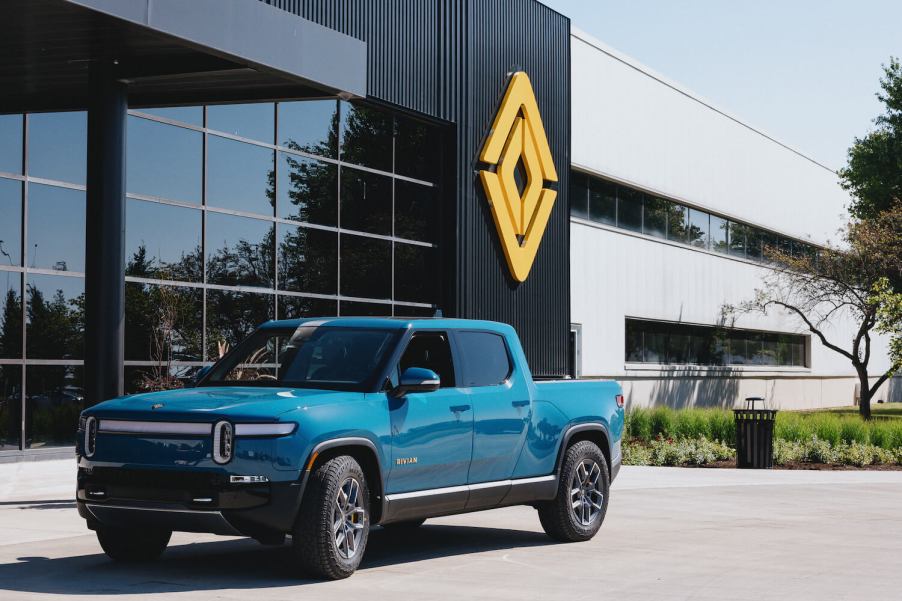
The Rivian R1T Is Not a Midsize Pickup Truck; It’s Also Not a Half-Ton
The Rivian R1T achieved a frunk-full of firsts: It is the first electric pickup to market, the first truck to get to 60 mph in 3.1 seconds, and the first vehicle by this Illinois-based EV startup. It also may require a new vehicle segment. While the Rivian R1T’s size is shorter than some Toyota Tacomas, its GVWR is high enough to technically be in the same class as a 3/4-ton heavy-duty truck.
What size is a Rivian R1T?
The Rivian R1T is pioneering an all-new segment. While the longest 2023 Toyota Tacoma is 226 inches bumper-to-bumper, the Rivian R1T’s only cab/bed configuration is 217 inches long. But while the Tacoma is 75 inches wide, the Rivian is 79 inches wide. That’s nearly as wide as the F-150 (79.9 inches).

Every Rivian R1T comes in the same size: a short bed and a two-door cab. The passengers in the back seat of a Rivian have 36.6 inches of rear legroom. That makes it smaller than every crew cab, including the Nissan Titan Crew Cab, which trails its segment with 38.5 inches of rear legroom. But the Rivian’s rear passengers enjoy more space to stretch out than any of the smaller four-door truck cabs, including the Ram 1500’s “Quad Cab,” which leads that class with 35.6 inches.
The Rivian’s bed is just 4.5 feet long and 51.1 inches wide. That’s the same length as the Ford Maverick’s bed, though the Maverick’s is actually wider and taller. But Rivian has engineered a double-hinged tailgate that creates a 6.9-foot load floor when dropped. It also offers under-bed storage for the spare tire and a “gear tunnel” between the bed and cab.
Why is the Rivian so short? One reason might be that the resulting 135.8-inch wheelbase that gives it a shorter wheelbase than any Tacoma. That’s an essential feature for an off-road-oriented pickup truck.
How much does the Rivian R1T weigh?
Lithium-ion battery packs are heavy. The 128.9 kWh long-range battery alone weighs 1,755 pounds and pushes the truck’s weight to 7,173 pounds (Car and Driver). The Rivian R1T has a GVWR of 8,532. It can offer a payload capacity of 1,384 pounds–depending on your battery size.

The United States classifies all commercial trucks by their GVWR (weight + maximum payload). Traditional midsize, half-ton, and heavy-duty pickup truck segments each group together neatly in an official class. Midsize trucks such as the Tacoma tend to have a GVWR below 6,000 pounds. Half-ton trucks, such as the F-150 and the 1500s, fall between a 6,001 and 8,5000 pound GVWR.
Classifying the Rivian truck is problematic. With its maximum GVWR of 8,532 pounds, some Rivian R1Ts are just over the threshold for “Class 2b.” This government-defined class is home to the F-250 and the 2500s built by General Motors and Ram. Manufacturers unofficially call this heavy-duty segment 3/4-ton trucks.
Note that the Ram 2500’s GVWR is 10,000 pounds. The F-250’s GVWR starts at 10,000, but you can upgrade it to 11,400 pounds. The F-250 can tow up to 17,200 pounds. The Rivian R1T’s 11,000-pound towing capacity and 1,384-pound payload capacity are impressive. But it is far from the 3/4-ton truck class in its capabilities.
How much do electric pickup trucks weigh?
The Rivian R1T’s curb weight (7,148 pounds) is heavier than the F-150 Lightning’s (6,015-6,893 pounds). But it is nowhere near the new Hummer truck’s 9,063 pounds. There’s no doubt about it, electric trucks are heavy.

Ford’s F-150 Lightning can have a GVWR anywhere between 8,250 and 8,550 pounds. This means that at the top end, the Lightning is also a 3/4-ton truck. But notice that Ford isn’t calling it the F-250 Lightning. The automaker knows doing so would mislead its customers seeking Super Duty capabilities. Ford’s labeling of the Lightning signals how badly we need a new government rating system for electric pickup trucks.
Next, find out if the Rivian R1T’s bed can fit a piece of plywood, or see how the Rivian’s size compares to the F-150 for yourself in the video below:





